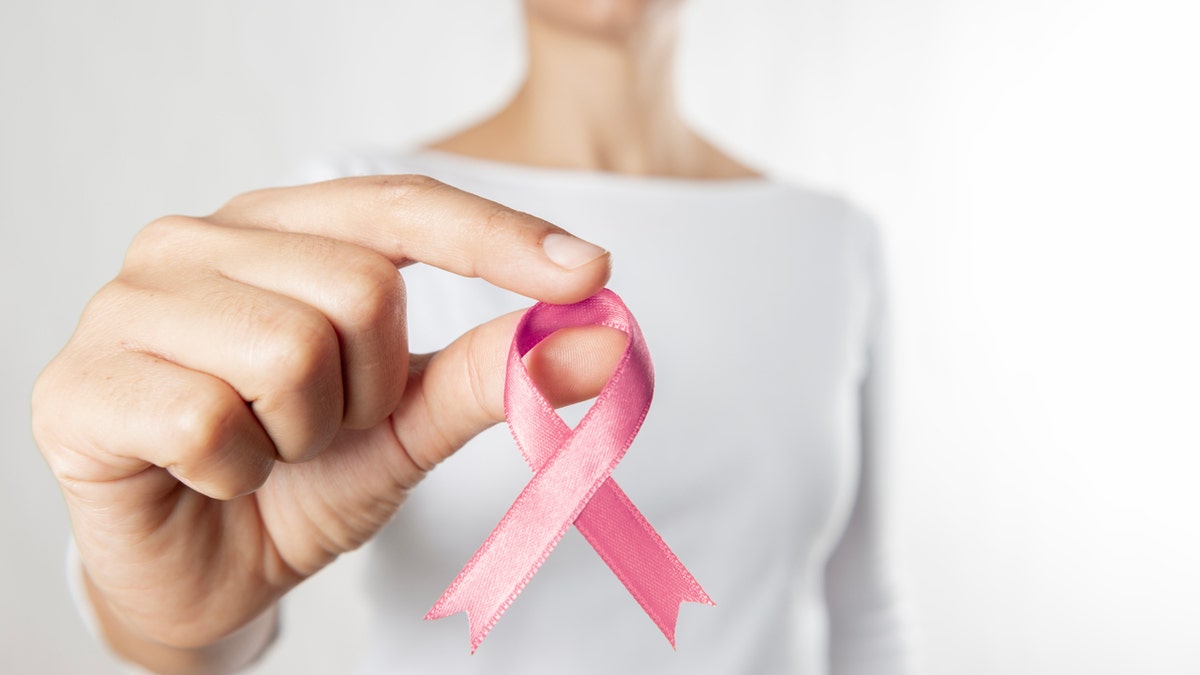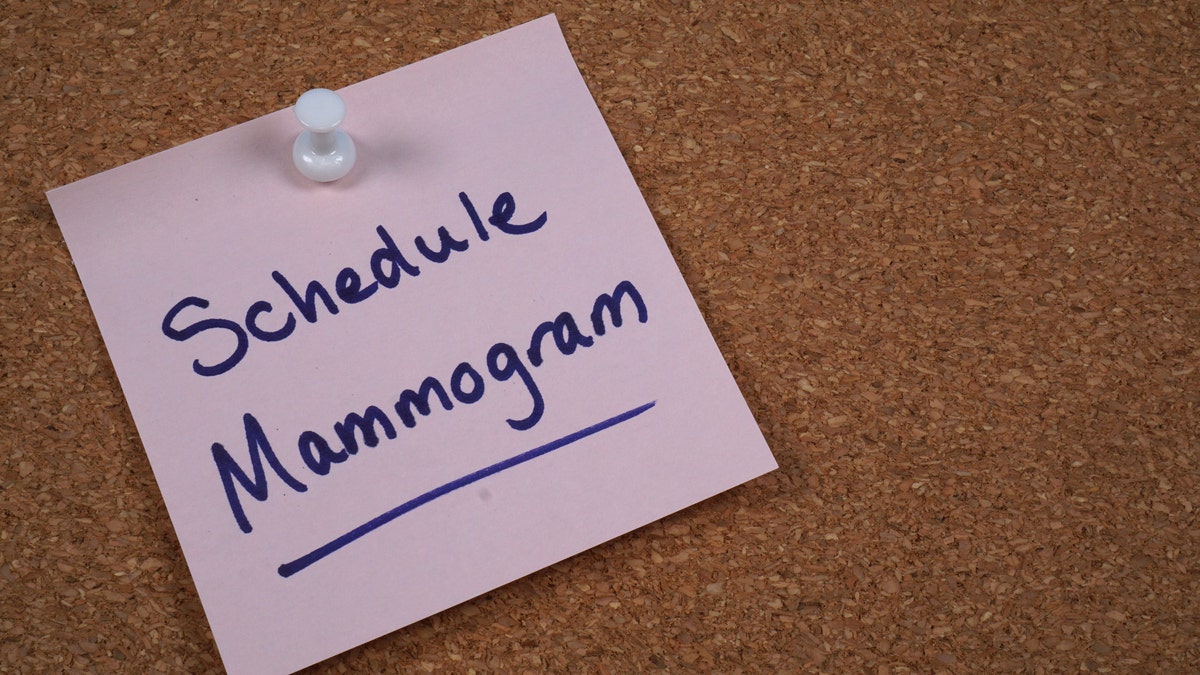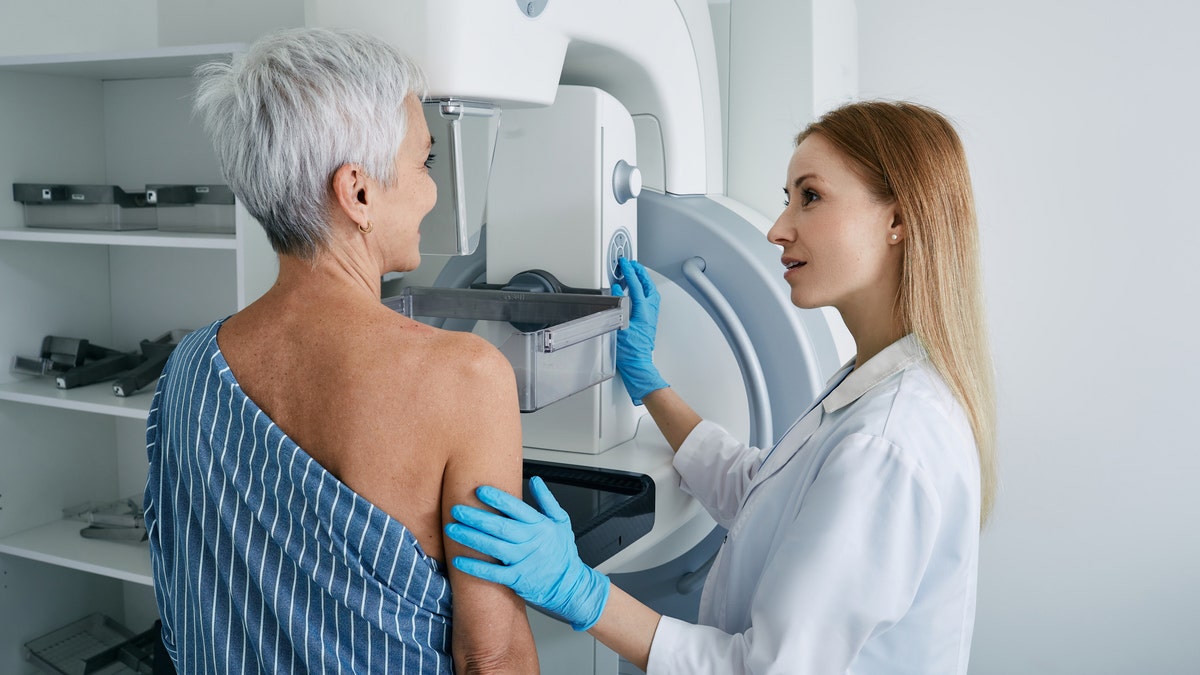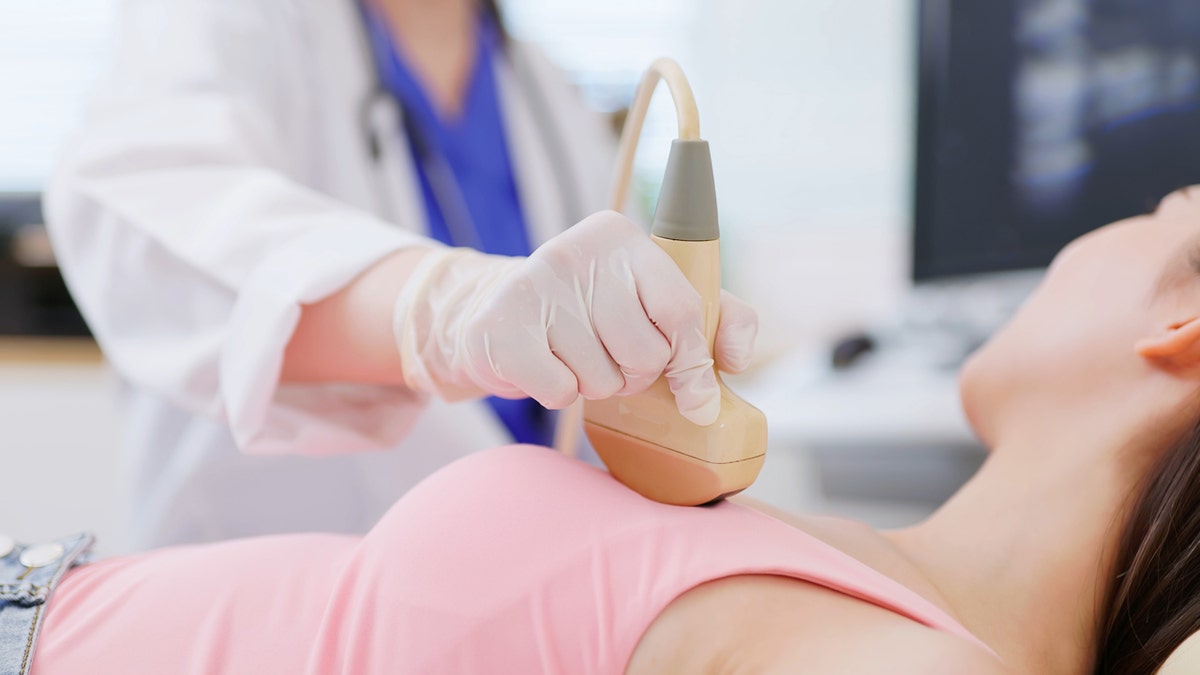Risk for breast cancer on the rise as deaths decrease: Study
Fox News senior medical analyst Dr. Marc Siegel explains how early detection for breast cancer has improved with the help of artificial intelligence and discusses the factors contributing to the rise in stress in America.
Breast cancer is the most common cancer in women, according to the National Breast Cancer Foundation, other than skin cancer.
One in eight women will develop breast cancer, according to the organization.
Women begin to get mammograms every year starting around the age of 40 to help detect breast cancer.
THESE 6 POWER FOODS CAN PREVENT CANCER, ACCORDING TO VARIOUS HEALTH EXPERTS
Here's a deeper look into breast cancer and information on how you can be screened for the disease.
- What is breast cancer?
- What are the symptoms of breast cancer?
- What is a mammogram?
- What should I know about mammogram radiation?
- What questions should I think about before my mammogram?
- Are there any breast cancer screening alternatives?
- At what age is breast cancer most common?
- What are the risk factors associated with breast cancer?

One in eight women will be diagnosed with breast cancer. (iStock)
1. What is breast cancer?
Breast cancer is a disease that occurs in breast tissue when cells in the breast "change and grow out of control," according to MedlinePlus, an online health information service produced by the U.S. National Library of Medicine.
The cells that cause breast cancer usually form a tumor, which is an abnormal mass of tissue.
DRINKING ALCOHOL IS LINKED TO SIX TYPES OF CANCER, EXPERTS SAY: ‘IT’S TOXIC'
Cancer cells and cancerous tumors (malignant) are dangerous because they can disrupt organ functions and kill healthy cells if left to spread.
This can cause serious harm or death if left untreated, according to a report from Medical News Today, a medical news website owned by Healthline Media.
Breast cancer is the second-most common cancer in women after skin cancer, according to the National Cancer Institute.

A biopsy can be done to diagnose breast cancer. (iStock)
The final step of diagnosing breast cancer is through a biopsy.
A biopsy is done after an imaging test, like a mammogram, is done and something is spotted that could be related to breast cancer.
PROSTATE CANCER SIGNS, SYMPTOMS AND LIFESTYLE CHANGES THAT COULD REDUCE YOUR RISK
The treatment for breast cancer commonly includes chemotherapy, hormone therapy or radiation.
2. What are the symptoms of breast cancer?
The most common symptom to look out for that could be associated with breast cancer is a new lump or mass.
If you do spot a new lump or mass form, it’s best to get it checked right away.
Other symptoms that could be associated with breast cancer are swelling of the breast or part of the breast, pain in the breast or nipple area, nipple retraction (when the nipple begins to turn inward), nipple discharge, or red, flaky skin.

One of the primary symptoms of breast cancer is a lump or mass. (iStock)
3. What is a mammogram?
One common breast cancer screening method is a mammogram.
This method of screening has led to debates among experts.
CANCER SCREENINGS: HERE ARE 5 TYPES AND CRITICAL INFORMATION TO KNOW ABOUT EACH
Potential risks associated with mammography screening include over diagnosis, false positives, anxiety and radiation injury, according to a study published in the National Library of Medicine.
A mammogram is an X-ray procedure that helps doctors detect early signs of breast cancer, according to the Centers for Disease Control and Prevention (CDC).
The machines used to conduct mammograms have plastic plates that flatten breasts so X-ray images can be taken and analyzed by radiologists for abnormalities.
Mammogram results are typically reported in a few weeks after the test is done.

Mammograms are a common way to screen for breast cancer. (iStock)
Women with dense breasts have a higher chance of getting breast cancer, the CDC reports. Some women have higher-density breasts if they’re younger in age, pregnant or breastfeeding, using hormone replacement therapy or have a lower body weight.
"Dense tissue can hide cancers," the CDC wrote in a report, "What Does It Mean to Have Dense Breasts?"
"Fibrous and glandular tissue looks white on a mammogram. So does a possible tumor," the CDC adds. "Because it’s hard to tell the difference between a tumor and dense breast tissue on a mammogram, a small tumor may be missed."
CANCER TRENDS REVEALED, INCLUDED MOST COMMON TYPES OF THE DISEASE AND BIGGEST RISK FACTORS
The U.S. Preventive Services Task Force, an independent, volunteer panel of national experts in disease prevention, states on its website their recommendation "that all women get screened for breast cancer every other year, starting at age 40 and continuing through age 74, to reduce their risk of dying from this disease."
The CDC also displays the guidance laid out by the U.S. Preventive Services Task Force on their website.
The American College of Physicians (ACP), the largest medical specialty organization in the world with 161,000 members in over 172 countries, according to its website, suggests waiting later for mammogram screening in those average risk patients.
"In average-risk women aged 40 to 49 years, clinicians should discuss whether to screen for breast cancer with mammography before age 50 years," the ACP states in a guidance statement published in 2019 in "Annals of Internal Medicine."
"Discussion should include the potential benefits and harms and a woman's preferences. The potential harms outweigh the benefits in most women aged 40 to 49 years," the ACP's guidance states.
In general, all cancer organizations advise women to speak with a health care provider to weigh the potential benefits and risks of getting a mammogram.

The age at which women are advised to get screened for breast cancer is up for debate, but, generally, age 40 is when women can begin regular exams. (iStock)
4. What should I know about mammogram radiation?
One concern among those getting a mammogram is the radiation involved, but many experts believe the risks associated with breast cancer outweigh the risks associated with a mammogram.
Dr. Jessica Shepherd, a Dallas-based OB/GYN who is chief medical officer at Verywell Health, a health information website, said most breast cancer cases are diagnosed after age 50, which is why mammograms are usually done for women who are closer to that age.
RISKS, SYMPTOMS AND TREATMENTS FOR LUNG CANCER, THE DEADLIEST CANCER IN THE WORLD
"The dose of radiation from a mammogram is pretty low and very rarely poses a risk, making them a safe diagnostic tool, and typically someone only needs a mammogram once a year. Therefore, there is no risk of too much radiation exposure," Shepherd told Fox News Digital.
She noted that there is a "small link to an increased risk of breast cancer over time due to [mammogram] frequency and also size of the breasts," but "overall this increase in risk is very small."
Delaying a breast cancer diagnosis has a higher risk than radiation exposure, Shepherd said.

Mammograms can be vital in catching breast cancer early. (iStock)
"When caught early, breast cancer is highly treatable, and mammograms can be highly beneficial in these cases," Shepherd continued.
"If [breast cancer is] allowed to advance, a patient may have to receive more complex treatment such as surgery or chemo, which is way more invasive than radiation exposure from a mammogram."
5. What questions should I think about before my mammogram?
There are certain questions a person should consider before making the decision to get a mammogram.
CLICK HERE TO SIGN UP FOR OUR HEALTH NEWSLETTER
Dr. Kathleen Kiernan Harnden, director of breast oncology at the Inova Schar Cancer Institute in Annandale, Virginia, told Fox News Digital there are three questions all women should ask themselves before they request a mammogram consultation or appointment:
- Do I have an increased risk of breast cancer?
- How can I reduce my risk for breast cancer?
- Will my mammogram be three-dimensional (3D) or two-dimensional (2D)?
Harnden recommends 3D mammography over 2D because multiple images are taken from different angles, which may make breast tissue analysis clearer.
6. Are there any breast cancer screening alternatives?
Other breast cancer screening methods exist for women who are not eligible or do not want to undergo a mammogram.
The CDC lists breast ultrasounds, breast MRI clinical breast examinations and self-checks as possible screenings for breast cancer.
Ultrasounds generate pictures, or sonograms, using sound waves, while MRIs are computerized body scans that generate pictures using magnets.

Ultrasounds are an alternative to getting a mammogram for breast cancer screening. (iStock)
Clinical breast exams are conducted by a doctor or nurse. During exams, medical professionals check for abnormal lumps or other physically detectable changes in breast tissue by hand.
Women can check their breasts for common breast cancer symptoms, including lumps, pain and changes in size.
For more Health articles, visit www.foxnews.com/health
"You should report any changes that you notice to your doctor or health care provider," the CDC wrote in its "What Is Breast Cancer Screening?" guide.
"Having a clinical breast exam or doing a breast self-exam has not been found to lower the risk of dying from breast cancer."
More screening alternatives, like nanotechnology and treatments with less radiation, are still being explored. Women diagnosed and those who do not have breast cancer can choose to participate in different clinical trials to help discover more screening alternatives and treatment options.

It's important to speak with your doctor about the screening method that works best for you. (iStock)
7. At what age is breast cancer most common?
Breast cancer incidence rates steadily increase with age, but it remains low for women under the age of 40, CDC data shows.
Female breast cancer rates by age group: CDC
- 15 to 19: 0.2 per 100,000 women
- 20 to 24: 1.8 per 100,000 women
- 25 to 29: 10.5 per 100,000 women
- 30 to 34: 30.1 per 100,000 women
- 35 to 39: 64.8 per 100,000 women
- 40 to 44: 131.7 per 100,000 women
- 45 to 49: 201 per 100,000 women
- 50 to 54: 240.7 per 100,000 women
- 55 to 59: 273.3 per 100,000 women
- 60 to 64: 339.8 per 100,000 women
- 65 to 69: 425.2 per 100,000 women
- 70 to 74: 475.8 per 100,000 women
- 75 to 79: 466.1 per 100,000 women
- 80 to 84: 420.7 per 100,000 women
- 85+: 318.2 per 100,000 women
While not all experts agree on whether women under age 40 should receive mammograms, young women in their 20s and 30s have been diagnosed with breast cancer, according to incidence data published by the CDC, which dates back to 2019.
Only about 9% of all breast cancer cases are found in women under age 45, according to the CDC.
With increasing age, the risk factors begin to grow. Most breast cancers are diagnosed after age 50, according to the source.
Since breast cancer is more commonly found in women 40 and older, medical professionals and organizations recommend routine breast cancer screenings for middle-aged and senior women.
8. What are the risk factors associated with breast cancer?
Alongside age, family history is another big risk factor for breast cancer.
"Having one first-degree relative with breast cancer doubles a woman’s risk," Harnden told Fox News Digital.
CLICK HERE TO GET THE FOX NEWS APP
Other risk factors highlighted by the CDC are reproductive history, previous treatments using radiation therapy, having dense breasts, exposure to the drug diethylstilbestrol (DES) and genetic mutations.
Factors like low exercise, being overweight, taking hormones, reproductive history and drinking alcohol are other risks associated with the disease that fall within an individual's control, according to the CDC.
Cortney Moore contributed reporting.





















